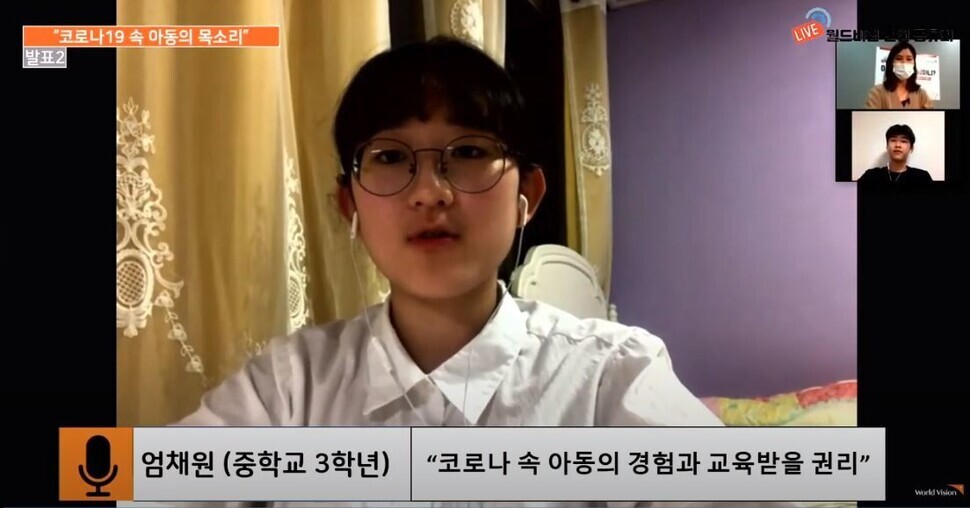hankyoreh
Links to other country sites 다른 나라 사이트 링크
Children, adolescents endure conditions of neglect and even abuse as COVID-19 crisis continues

“Since the COVID-19 outbreak began, all schools and churches have been closed. Jeong-hun has to prepare all his food, and he only has 4,000 won (US$3.44) for each meal.”
Park Yun-a, 12, was worried by what she’d heard about her friend 11-year-old Jeong-hun (pseudonym). Jeong-hun, who lived with his grandparents, used to skip breakfast, eat lunch at the school cafeteria, and grab free meals at churches on the weekends. But the closure of schools and churches amid the COVID-19 outbreak left Jeong-hun without his usual meal options. Yun-a suggested setting up a volunteer group to deliver meals to undernourished children or opening up a cafeteria with vending machines that would be accessible to such children.
Teenagers have been dealing with the COVID-19 crisis for more than half a year now, and they’re starting to complain that social distancing is infringing on the rights of children and teenagers. On Sept. 14, a tragic incident was reported in which two brothers in elementary school who were at home, taking classes online, suffered severe burns while trying to cook ramen noodles. In an online seminar about children’s rights and COVID-19 that World Vision held the next afternoon on YouTube and other media, teenagers called on South Korean society to take action about the problems faced by such children.
Teenagers are also expressing concerns about children who are subjected to abuse or neglect as their families are cut off from the outside world by COVID-19. “Children are exposed to the risk of domestic violence. Since they can’t go to school, they don’t get noticed by their teachers, which basically eliminates any practical means for them to get help. We need to pay attention to each other,” said Yang Jun-seok, 15.
“When both parents are on the job, children are left alone at home and don’t have anybody to look after them. Children who are home alone have a hard time preparing meals or even just entertaining themselves. We need a policy to support young children,” said Park Yu-bin, 15.
Widening education gap as pandemic continuesChildcare is one of the major difficulties faced by impoverished families in the COVID-19 crisis. When World Vision surveyed 1,062 guardians of poor children back in May about family difficulties during the COVID-19 pandemic, the most common response was earning a living (60%), followed by childcare and education (28%). Among those who reported difficulties in childcare and education, 48.6% were worried about the widening educational gap and preparing for the future, while 27.5% were worried about the growing burden of childcare and the increasing amount of time that children are spending alone.
Teenagers are also vulnerable to achievement gaps caused by their educational environment, and they say that such concerns are becoming a reality in the classroom.
“In-person classes and educational guidance are particularly important in Gangwon Province and other areas where there’s a weak educational environment, but none of those things are taking place. I can feel that the disparity in academic achievement between students is getting worse,” said Eom Chae-won, 15, who lives in Wonju, Gangwon Province.
“It isn’t fun when the teacher is giving a one-sided lecture online and we have to just sit there and listen. After 10 minutes, you start getting distracted. What’s the point of school if our classes only consist of monologues by the teacher without any dialogue with the students?” said Kim Su-min, 13, who started middle school this year.
By Chai Yoon-tae, staff reporter
Please direct comments or questions to [english@hani.co.kr]

Editorial・opinion
![[Column] Life on our Trisolaris [Column] Life on our Trisolaris](https://flexible.img.hani.co.kr/flexible/normal/500/300/imgdb/original/2024/0505/4817148682278544.jpg) [Column] Life on our Trisolaris
[Column] Life on our Trisolaris![[Editorial] Penalties for airing allegations against Korea’s first lady endanger free press [Editorial] Penalties for airing allegations against Korea’s first lady endanger free press](https://flexible.img.hani.co.kr/flexible/normal/500/300/imgdb/original/2024/0502/1817146398095106.jpg) [Editorial] Penalties for airing allegations against Korea’s first lady endanger free press
[Editorial] Penalties for airing allegations against Korea’s first lady endanger free press- [Editorial] Yoon must halt procurement of SM-3 interceptor missiles
- [Guest essay] Maybe Korea’s rapid population decline is an opportunity, not a crisis
- [Column] Can Yoon steer diplomacy with Russia, China back on track?
- [Column] Season 2 of special prosecutor probe may be coming to Korea soon
- [Column] Park Geun-hye déjà vu in Yoon Suk-yeol
- [Editorial] New weight of N. Korea’s nuclear threats makes dialogue all the more urgent
- [Guest essay] The real reason Korea’s new right wants to dub Rhee a founding father
- [Column] ‘Choson’: Is it time we start referring to N. Korea in its own terms?
Most viewed articles
- 160% of young Koreans see no need to have kids after marriage
- 2[Reporter’s notebook] In Min’s world, she’s the artist — and NewJeans is her art
- 3[Column] Life on our Trisolaris
- 4Hybe-Ador dispute shines light on pervasive issues behind K-pop’s tidy facade
- 5Months and months of overdue wages are pushing migrant workers in Korea into debt
- 6[Editorial] Penalties for airing allegations against Korea’s first lady endanger free press
- 7Presidential office warns of veto in response to opposition passing special counsel probe act
- 8Japan says it’s not pressuring Naver to sell Line, but Korean insiders say otherwise
- 9S. Korea discusses participation in defense development with AUKUS alliance
- 10[Column] “Hoesik” as ritual of hierarchical obedience